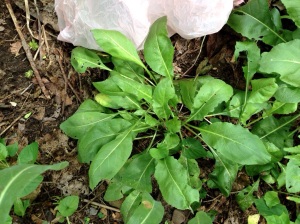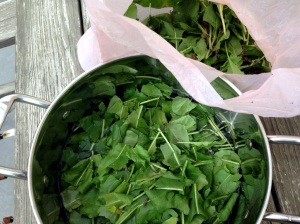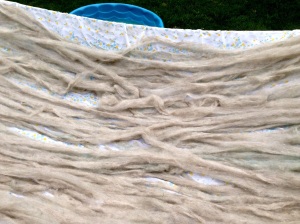July was an odd month for various reasons.
- I was away at the monastery for a few days of deep silence with six hours of quiet train travel to and from bookending my stay there
- We three learned (gradually) not to be surprised when we walked on our new kitchen floor, a June ordeal and acquisition
- Carmen the dog showed her age in the rather abrupt onset of back pain requiring an emergency vet visit
- And, on or about the first of July, Bruce began peeing in an old soup stockpot.
Rest assured, I will not be making soup with that particular pot ever again.
He was helping me prepare a woad fermentation vat (also known as a urine or sig vat) by donating urine, and by the time I returned from the monastery on the 11th, the stockpot was full enough to set aside in the basement whilst its contents grew stale.
Shortly after that task was completed, a string of rainy days allowed me to collect enough rainwater for the extraction stage of our little woad journey. Woad extraction requires soft water, and our rainwater was soft. Off the charts soft.
Early in the day on Saturday the 19th of July, I harvested the slim collection of woad plants left growing under our backyard dogwood. Pippa the dog, who began gracing our family with her exuberant presence in late March of this year, has been carving a bit of a path into the woad bed, and has effectively thinned the crop just by dashing straight into it every time she flies out the back door. –sigh– She is a handful, that dog, Pip. In all the best possible ways.
No worries though. There were enough leaves to fill my smaller stockpot. I cut the plants near their base, then shredded the gathered leaves by hand. They are not tough so that was an easy task, and a task filled with promise as my fingers were lightly stained with blue before I was done.
Once done, I took the pot inside, put it on the stove, brought the rainwater/shredded leaves mix just shy of boiling, and then kept it at about 175F on the stove for 10 minutes. While the leaves were steeping, I filled our kitchen sink with water and ice, and when 10 minutes were up, I plunged the whole pot into the ice-bath and stirred the contents as I watched the thermometer plummet. Within four minutes the temperature was a healthy 130F and the mix was ready to strain out the leaves.
I took the pot outside, poured its contents into a colander over a bucket, and squeezed as much moisture out of the leaves as I could before discarding them. Then I poured the liquid back into the pot and waited for it to cool a little further, to about 120F or less, before proceeding to the next step.
While the liquid cooled, I prepared a mixture of soda ash and boiling water — about 3 teaspoons of soda ash mixed in a mug-sized container of the hot water. Once the soda ash dissolved and the mixture had cooled down a bit, I added it to the pot of woad liquid. Then, using a handheld electric mixer, I whisked the pot’s contents for about 10 minutes, watching as the froth turned from brownish-green to blue then back to green. So far so good!
A pH test told me the mix was about as alkaline as it could be. And here is where, maybe, things took a wrong turn.
You see, the instructions I was following (primarily — I did use a few other sources to confirm what I was reading) are for making a powder of the dyestuff and, had I followed them to the letter, this is the point at which I would, perhaps should, have employed the use of a series of glass jars, sedimentation, a glass pipette, and a whole lot of patience. I used none of those, and instead poured the contents of this pot directly into the stockpot full of stale urine, popped a lid on the mix and secured it with a short bungee cord.
The fermentation vat (which is what that stale urine-filled stockpot is) needs to hover between 95 and 109F. It can be cooler than that, but that will slow the action just like yeast in bread dough. Too much heat will kill the action — again, just like yeast in bread dough. It being summer here, and all, and our back patio often feeling slightly too warm for comfort, I assumed setting the vat on the stones there would keep it warm enough without getting too hot. And then? Then we had a string of cool and rainy summer days.
But I kept hope alive and, after returning from a short stint in Boston, I checked the vat and found little change in the color of the liquid. However, there was evidence that all the right things were occurring: a coppery scum had begun to collect on the surface. And so — prematurely, I freely admit — I popped a bunch of roving into the pot after soaking it in water collected from our dehumidifier. Recognizing that the vat might not be warm enough, I put the whole thing into a plastic garbage can we keep on the north side of our house to collect yard waste. The can, when the lid is snapped on tight, is a little bit of a hot house, but not too hot as it is more often in the shade than not. I left the pot there overnight and checked the roving in the morning by lifting it slowly out.
Nothing. Well, a definite stale pee hue, but no blue. So I put the roving back in, closed everything up and left it for four days. Still nothing, or next to nothing. You be the judge.
I took the wretched smelling roving out, rinsed it carefully a few times in cool water, hung it out to dry and returned the vat to my improvised hot house/yard waste bin. A couple of days later: better-looking vat contents with clear-ish green liquid and a more-pronounced coppery bloom on the surface led me to try again with another bit of roving. This time we went to Philadelphia for a couple of nights before I removed the wool. And another disappointment.
I will be spinning both bits of roving before trying them again in order to spare them from felting. And I may have to replenish the vat by processing a whole other batch of woad leaves. Which might just work as in the interim the woad has self-seeded and produced a small crop.
My knowledge of chemistry is not great, but what I think I have gleaned from various sources is that the indigotin/indoxyl must be extracted from the woad leaves, hence the steeping, quick-cooling, alkalinity, and mixing. Indigotin is the molecule that makes fiber blue, and it is extracted in an alkaline solution that must be aerated. The dye however will not attach to fiber without being converted into leuco-indigo through fermentation, the process which strips the molecule of oxygen (thank you, bacteria), and changes it to “white indigo.” Which is why, when you lift the fibre from the vat, your stomach might drop a bit at the awful color until it transforms before your eyes as it connects with oxygen again and turns blue. Or so I hear tell. I have yet to witness it except in the tiniest of teasing glimmers.
A night or two after I skipped the whole sedimentation part of this production, I woke up from a dead sleep and thought, well. This method (if it is one — I still had my doubts) I have chosen could take a whole lot longer if it works at all, because along with all the indigotin, I just dumped a pot-load of H2O into the vat of pee. That’s a whole lot of extra oxygen to digest. If indeed it works that way. I spent most of my spare time over the next few days searching the internet for a hint that someone, anyone had trod this particular path I’d chosen, and was reassured somewhat by a few accounts.
I do regret not paying closer attention to my studies in high school chemistry. Not that Mr. Theophanis ever talked about dyeing with woad. I will try again. People did this for hundreds of years without benefit of thermometers, swimming pool test kits, and stoves, freezers or Rubbermaid garbage bins. Right?
All you could ever hope to know about woad here: http://www.woad.org.uk/
With a bit more added on here: http://localcolordyes.com/blog/
















Ah, Patti, it looks like it wants to dye so badly — poor little woad leaves are working so hard! I’ve only used natural powdered indigo, which has (obviously) already been extracted from the leaves, and is a lot more concentrated dye than woad even on a bad day. But fresh-grown woad! It’s exciting. With my indigo sig vat, I found that even the cool August-September evening temps were enough to slow down the fermentation and kept the vat from really getting going. I ended up wrapping a heating pad around it in order to keep the heat level up overnight, and that’s how I finally got it going. In the end, with woad or indigo, patience really is the key. MrJ empathizes with Bruce — pee donors unite?
Bruce has a t-shirt design in mind, should Mr. J be so moved. 😉